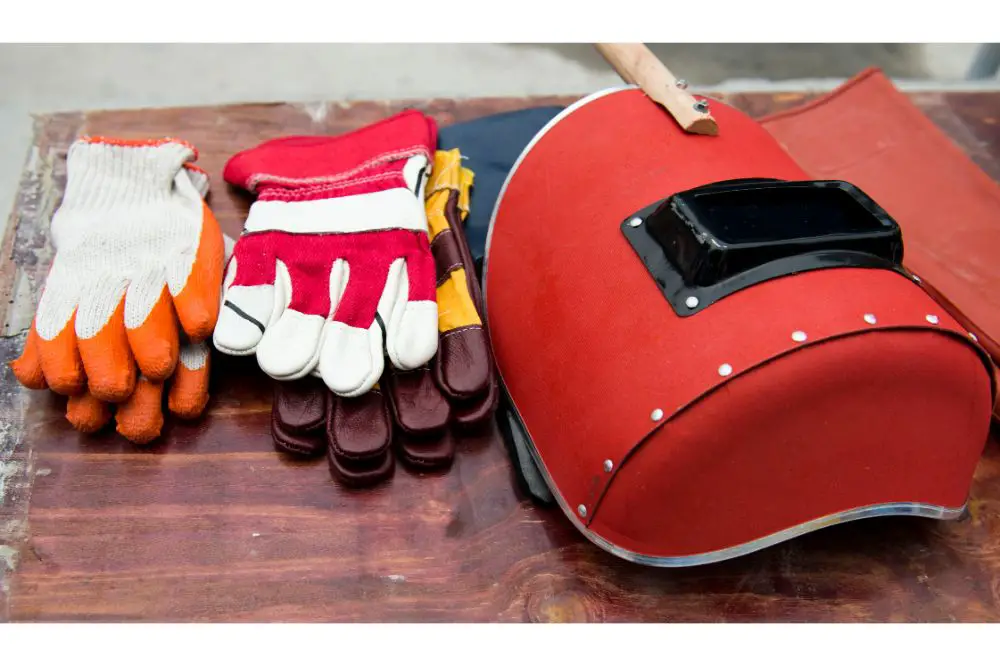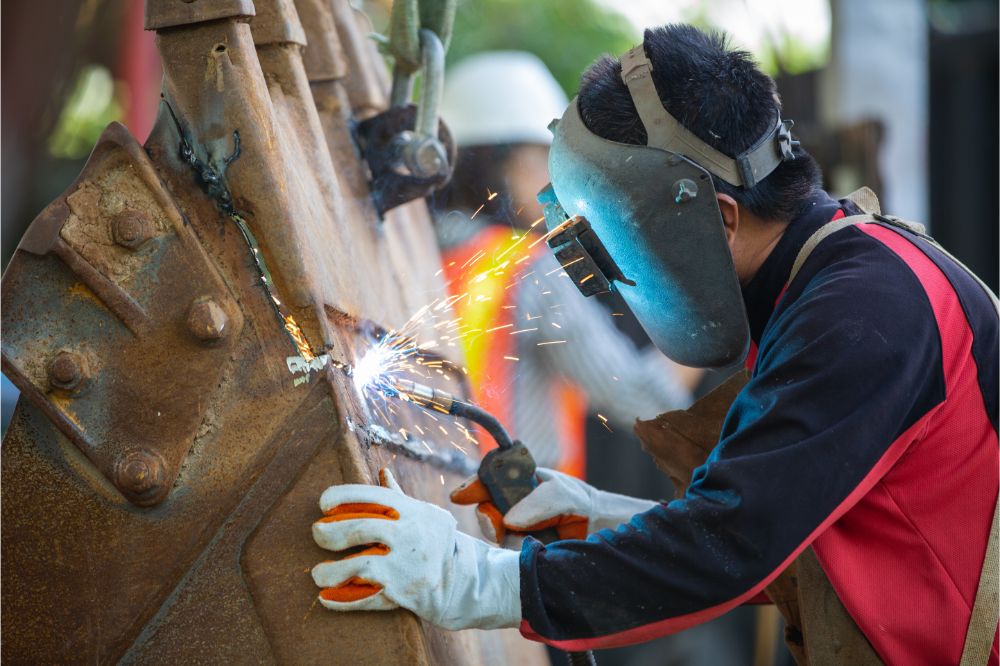Welding gloves are one of the essential gears you need to perform any welding job. They keep your hands safe and give you a better grip on the welding equipment. The material used in making the gloves is an essential concern to every welder because it determines the gear’s flame resistance, flexibility, and durability.
So what are the common materials used in making welding gloves? This article will highlight the materials used in making welding gloves and what makes them a perfect fit. Read on to get valuable tips on selecting an ideal glove for your welding.
Why You Need Welding Gloves
So, why do you need welding gloves? Why not go for ordinary gloves?
Welding has many hazards, including burns, electric shock, infrared radiation, and cuts. Thus, it would be best if you had a pair of gloves with great abrasion resistance, electrically nonconductive, and flame resistant. Welding gloves are personal protective equipment (PPE) built to protect your hands from hazards associated with welding.
Unlike ordinary gloves, they are durable, heat-resistant materials, and poor electric conductors. As a result, they protect your hands from electrical shock, hot metals, sparks, and sharp and rough objects. Additionally, the gloves are designed to give you a good grip on the welding equipment.
What Are Welding Gloves Made of
Typically, the main material used in making welding gloves is leather because it is durable, dissipates heat well, and is electrically nonconductive. Also, leather gloves are lined with insulation to make them comfortable and to protect your hands better.
Main material-Leather
Manufacturers use different types of leather depending on the desired level of heat protection, agility, and flame resistance. Below are some of the common leather types used in making welding gloves.
- Cowhide
Cowhide includes many excellent features ideal for welding gloves. The material is durable, resistant to abrasion, and heat and flame resistant. It is ideal for welding that involves a lot of heat and splattering. Also, it offers good protection against cuts by sharp and rough objects.
- Goatskin
Another great leather material used in welding gloves is goat skin. Unlike cowhide, this one is lightweight and offers great flexibility and agility. Most welders prefer goat skin to other materials because of its comfort and ease of maneuvering. This type of glove makes an excellent choice for welding with great precision.
- Deerskin
Those made from deer skin are ideal if you are looking for a soft and super comfortable glove. Deerskin is light and smooth to give you great touch sensitivity and skill, especially when handling small items. In addition, as a welder, you will appreciate the precision of gloves made from deer skin.
- Elk leather
Another commonly used material is elk leather. This premium-grade leather is modified to offer great dexterity and heat resistance. It is soft and comfortable and allows you to weld easily. Additionally, it can shield you against burns, cuts, and abrasion.
- Pigskin
Pigskin offers excellent breathability and is an ideal choice if you are looking for gloves that dissipate body heat. However, it has poor heat resistance and is unsuitable for welding with high heat levels.
- Grain leather
Another material that gives good dexterity and abrasion is grain leather. Gloves made from this type of leather are light and ideal where you desire freedom of movement as you weld.
Lining Material
Welding gloves are lined with insulation layers to make them soft and for better protection of your hands. In addition, most of these liners enhance sweat-wicking and prevent micro-organisms causing disease from building up.
Some of the common lining materials used include:
- Thermosock insulation
- Thinsulate
- Foam lining
- Fleece cotton
- Wool Lining
A good lining material should keep your hands dry to give you a better grip on the welding gun.

What Makes a Perfect Pair of Welding Gloves?
A perfect pair of gloves give you the desired level of protection against heat, electrical shock, and cuts. Also, the gloves should be flexible enough to allow you to take a wide range of motion while working. The required protection and skill levels vary from one type of welding to another. So, a pair of gloves perfect for stick welding is not ideal for TIG welding.
So, how do you know which gloves are a perfect fit? Below are some of the features that will guide you in selecting a glove that suits you
Level of heat protection
A good pair of welding gloves give you the required heat protection. When selecting a glove, consider the heat levels associated with your welding process and choose those that shield you from splatters and sparks.
Durability
As a welder, you want a pair of gloves that will give you service for a long time before you can replace them. Thus, go for ones made of materials resistant to wear and tear. For example, welding gloves made with goat skin or cowhide are known for their durability.
Dexterity
Other welding items will require a high level of precision; in this case, you will need flexible gloves for great accuracy. Gloves made from soft and lightweight materials allow you to maneuver easily. Therefore, they are an excellent choice where high precision is required.
Protection against sharp metals
When performing any welding job, you will encounter sharp and rough metal pieces; therefore, you want gloves that can protect you against cuts and scratches. Gloves with great abrasion resistance are an excellent choice in this case.
Good Fit
A glove is only functional if it perfectly fits your hand and does not slip when welding. Go for a size that will stay put in your hands during the welding process; otherwise, a glove that slips will not give you the required comfort and protection.
Types of Welding Gloves for Different Welding Processes
MIG welding
MIG welding involves high heat levels and lots of sparks and splattering. Thus protective gloves used in this process are thick with many layers to protect your hands from heat. In addition, the leather materials used in making these gloves are high quality and with great flame resistance. The common type of leather used is goat skin. However, other materials such as top grain, cowhide, and deerskin are sometimes used.
TIG Welding
TIG welding gloves are made with light and flexible leather to give high dexterity. The gloves provide the freedom of movement required to make precise TIG welds. TIG welding is associated with low heat levels, and few spatters; thus, the gloves consist of few layers, contributing to their flexibility.
However, to protect your fingers from hot surfaces, this pair of welding gloves are designed with extra padding around the palm area and outer part of the hand. Also, these gloves are designed to allow you to remove them easily when necessary. You will want to avoid TIG gloves that come with Velcro straps as they are hard to remove, especially in an emergency.
Read also: The Difference Between MIG and TIG Welding
Stick welding
Stick welding is associated with a high level of heat and splattering. Thus, gloves made for this purpose are heavy-duty to give you great protection. The common material used for stick welding gloves is heavy-weight split leather. Additionally, the gloves are lined with insulation material such as foam or cotton liner to offer maximum protection to your hands.
Stick welding comes with less precision, so you do not have to worry about the poor skill of the gloves. Instead, go for thick layered gloves that shield your hands from burning.
Conclusion
The main material used in welding gloves is leather because of the great heat resistance, durability, and abrasion resistance. However, different types of leather come with varying heat protection and dexterity levels.
So, when selecting a glove, go for a material that matches the functional requirements of your welding. It should give you the required protection and allow you to take a wide range of movements when working.

